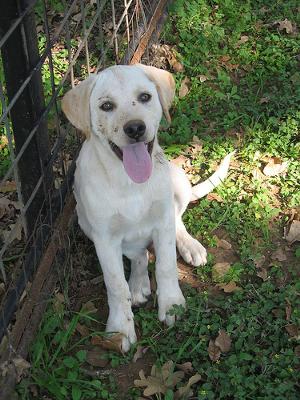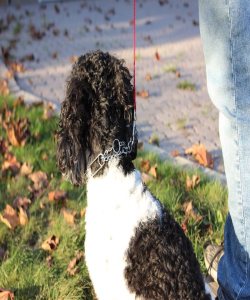4 month old Lab mix

From a Reader... Our family just got a 4 month old pup a week ago. She gets aggressive towards me every time she plays with me or when she wants to play.
I don't rough house or play tug-a-war with her. I try to play fetch or take her on walks up and down our street, that is as far as our vet says she can go for now.
When playing fetch she will go after me and on walks she starts attacking the leash or me. I tried yelping "ouch" but she comes back harder and then will growl and keep attacking me. She does this to my kids rarely and never to my husband.
I am unsure about her shot records (previous owner did not provide a copy of them). Therefore I cannot take her to any parks or dog training classes until she has had her second round of shots...vet orders.
Please help! Thanks.
Shannon Says...

Thanks for your questions!
It's very common to have this problem, believe it or not. Don't worry - this is NOT aggression that you are dealing with. Aggression will not manifest itself until a puppy/dog is at least nine or ten months old.
What you are seeing is simply a very high play and prey drive in your puppy. And the best way to channel this energy into proper activities is to train her using a balanced method what is appropriate and what is not.
To do so, you must correct her when she behaves inappropriately and praise her when she does the right thing. Praise can be giving her a small treat, petting, or simply verbal praise.
Labs and lab mixes have the tendency to chew or get excessively hyper in play (and even when you're not playing with them!).
Solutions for Nipping
Tools you need:
> 6 foot leather or nylon leash
> small boat air horn (should fit in your hand) - Canadian Tire usually carries them
> training collar - please read our page about collars to decide which one to use
> some soft, stinky treats (not too many)
> bitter apple spray
Spray your leash with the bitter apple to deter her from chewing it. You can also use this spray on anything else you don't want her to chew.
Spend a week desensitizing her to the training collar. What do I mean?
Use her regular collar for walks, but have her wear the new training collar as well. Put this new collar on for play, for feeding, and anytime someone is home to supervise. She can wear it all day, as long as she gets at least 8 hours "naked" (no collar) at night.
Never crate or leave unsupervised with a training collar on! You want her to have a positive association with the training collar, not a negative one.
Once this week is up, you can begin leash and collar training. Clip the leash onto the training collar (this should be the very first time this has been done), and proceed to take a walk.
Your best best is going to be teaching her to heel beside you, on your left side.

Be sure that the training collar is fitted up high under her chin and behind her ears. This is called the tender zone, where she has the least amount of muscle on her neck. You should be able to fit only two fingers between the collar and her neck.
Say "Fido, heel!" and take a step forward with your left foot. Again, she should be on your left side.
Hold the leash with your right hand near your naval, and your left hand grasping it a few inches above the clasp, without pulling it tightly.
If she tries to go ahead of you, say nothing, loosen the leash for a split second by swinging your left hand/arm forward, pop it straight back horizontally with her spine (you may need to bend over a little) fast and firm, and then loosen the leash again.
The collar should go tight for only one second. If she goes even an inch ahead of your ankle again, repeat the correction, saying nothing.
If it seems as if you are doing this every 10 seconds or more, your corrections haven't been firm enough or the collar is not fitted properly.
If she bites at your hands, you can try giving her a firm tap under the chin with a closed hand. Otherwise, loosen the leash for a second, pop up vertically (fast, firm, and on time), and loosen it again - say nothing.
You want her to always associate a correction with her behavior, not with you, so that is why you don't want to give a verbal cue while you correct.
Boat Airhorn: You can use this either in the house or outside. Hold it behind your back so she can't see it, and press and hold the button for 3 to 5 seconds to startle her when she tries to nip or jump at you.
In the house: You can keep her on leash in the house so that you are always prepared to correct her if she nips at you. Just let it drag around. For jumping, pop the leash down. You can tie on a small piece of rope instead of the leash in the house if you don't want her to chew it.
How NOT to Stop Nipping
> point finger and say no (it's a visual threat)
> grab the puppy's muzzle and squeeze it - she will try to bite your hand or get overly submissive
> pinch lip to tooth on puppy - dog will become hand shy
> shake her by the scruff to mimic mother dog - again, will become hand shy or will retaliate
> pin dog down (Ceasar Milan's alpha roll) - a correction should only be one second
Proper Solutions for Nipping
> verbal "Eh!" loudly to startle them
> tell her to sit (reroute the energy into something positive)
> give a firm tap under the chin
> collar and leash correction (as outlined above)
> exercise! As she is 4 months old, she can easily get two 15 minute walks a day. Exercise is one of the best preventions of any behavioral problems.
Possible Reasons behind her behavior:
> you let her sit your lap
> you pet her when her paws are up on your knees
> can start with teaching shake-a-paw
Wow! That was a little longer than I had intended! Hopefully you will be able to better deal with the issues you are facing now.
Good luck, and definitely get into a balanced obedience class when possible!


